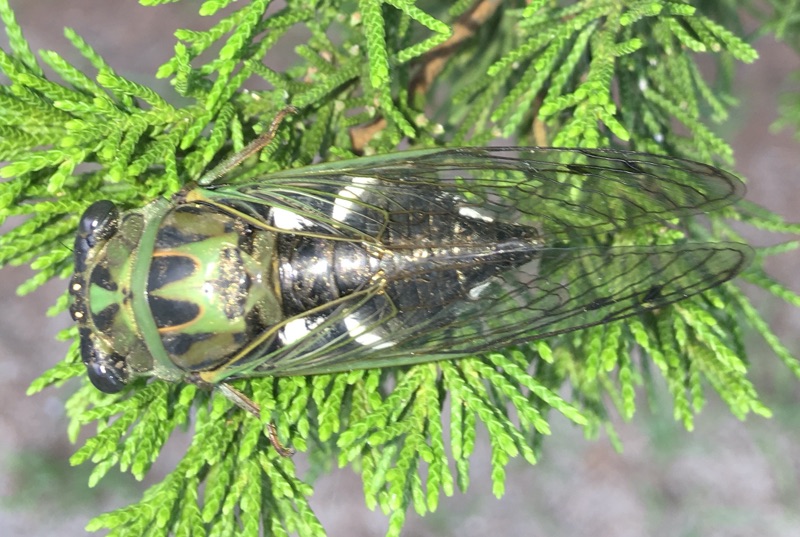Neotibicen latifasciatus (Davis, 1915) aka Coastal Scissor(s) Grinder Cicada!

See all Neotibicen latifasciatus images & information on cicadamania.com.
Song
Source: ©Insect Singers.
Name, Location and Description
- Cicada Name: Neotibicen latifasciatus (Davis, 1915)
- Short Name: N. latifasciatus
- Common Name: Coastal Scissor(s) Grinder Cicada
- Synonym/Former Name: Tibicen latifasciatus, Cicada pruninosa var. latifasciafa
- When: July-October. Peaks in September.
- Where it is found: FL, MD, NJ, NC, VA
- Maps: Biogeography of the Cicadas (Hemiptera: Cicadidae) of North America, North of Mexico [PDF]
- Description: If the cicada has a white X on its back, it is a latifasciatus. Repetitive, rhythmic, call like someone repeatedly running a scissor over a grinding wheel.
- Eye Color: brown
- Pronotal Collar Color: brown or green
- Identification: Bug Guide
- Identification: Bill Reynolds on iNaturalist
- Identification:: iNaturalist
- Subject Matter Expert website: Cicada Central
- Taxonomic Information: Integrated Taxonomic Information System
- Song: Insect Singers
Wm. T. Davis description
Neotibicen latifasciatus was described in 1915 by Davis in the article Notes on Some Cicadas from the Eastern and Central United States with a Description of a New Variety of Cicada Pruinosa in the Journal of The New York Entomological Society. 1
Smith and Grossbeck say of the specimens they had from the coast of New Jersey and which we now know to be a variety: “Abdomen above black, base of first segment with a white, heavily pruinose lateral dash, which encroaches to some extent upon the second segment; a similar but longer and broader lateral dash extends along the base of the third segment and a spot of the same color is on each side of the eighth segment. In the female the dash of the second segment differs from that of the male in not becoming attenuated dorsally, but in being squarely truncated.”
For the variety thus described with the broad white lateral dashes on segment three, we propose the name of latifasciafa. We then have Cicada pruninosa [now Neotibicen pruinosus] as described by Say, with the tergum entirely black or nearly so, with the attenuated white stripe at the lateral base of the third abdominal segment, being the form common from Indiana, Missouri, Nebraska, Kansas, etc., of which we figure a male from Chetopa, Kansas ; Cicada pruinosa var. latifasciata so far known only from the coastal region of the eastern and southern United States, with the broad stripe on segment three and abdomen beneath more shining black, of which we figure a male from Cape May Co., New Jersey, and Cicada pruninosa var. winnemanna [now Neotibicen winnemanna] with the hind margins of the abdominal segments more or less fulvous, the second segment having the band broader than the others and a white streak generally hardly discernible each side at the base of the third segment, of which we figure a male from Plummer’s Island, Maryland. The females of these cicadas have the charactertistic markings far less distinct than in the males and occasionally some are entirely absent.
Identification key by Wm T Davis2
A. Large, heavy bodied species ; head broad, uncus simple, and first cross vein in the fore wings starting from radius 3 far back, or about one third distant from base of first marginal cell.
B. Uncus longer than broad. Black species with green or greenish markings and black area on the central part of the abdomen beneath, except in sayi, and new variety of davisi.
C. Hind margin of pronotum or collar, green or greenish.
Dorsum of abdomen shining black with a broad pruinose mark each side on segment three ; blackened area on under side of abdomen more in the nature of an even stripe.
pruinosa var. latifasciata (Davis.)
Classification:
Family: Cicadidae
Subfamily: Cicadinae
Tribe: Cryptotympanini
Subtribe: Cryptotympanina
Genus: Neotibicen
Species: Neotibicen latifasciatus (Davis, 1915)
List of sources
- (1) Davis, W.T. 1915. Notes on Some Cicadas from the Eastern and Central United States with a Description of a New Variety of Cicada Pruinosa. Journal of The New York Entomological Society. Vol 23, Pages 1-10. Read on archive.org.
- (2) Davis, W.T. 1918. Mississippi Cicadas, with a Key to the Species of the Southeastern United States. Journal of The New York Entomological Society. Vol. XXVI. Read on archive.org.
- Full Binomial Names: ITIS.gov
- Common names: BugGuide.net; The Songs of Insects by Lang Elliott and Wil Herschberger; personal memory.
- Locations: Biogeography of the Cicadas (Hemiptera: Cicadidae) of North America, North of Mexico by Allen F. Sanborn and Polly K. Phillips.
- Descriptions, Colors: personal observations from specimens or photos from many sources. Descriptions are not perfect, but may be helpful.
Notes:
- Some descriptions are based on aged specimens which have lost some or a lot of their color.
2 replies on “Neotibicen latifasciatus (Davis, 1915) aka Coastal Scissor(s) Grinder Cicada”
I live in suburban Montgomery Co. Maryland and I’m used to hearing scores of these cicadas singing in August. This year I hardly hear any, or any other species either. Is this a normal variation in population, or are they dying out like the fireflies?
I found my cat toying with one. Took pics, Google lensed it and ended up here. You might want to look into updating what states they are found in, because I am in New York near the Connecticut border and they’re everywhere here!